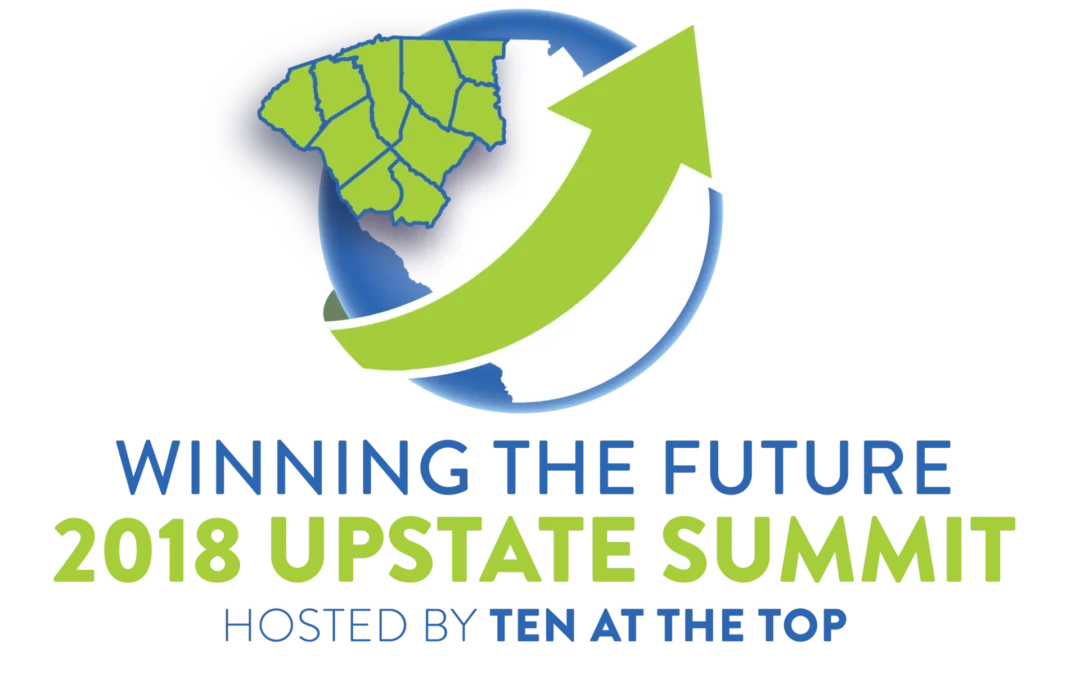

10th Anniversary County Workshops
10th Anniversary County Workshops Ten Years of Connecting the Upstate Ten years ago, when Ten at the Top started, we held a series of workshops in each county to ask business and community leaders as well as interested residents what matters most looking to the...
Workshops and Speakers Announced for 2019 PIQUE Young Professionals Summit
GREENVILLE, S.C.– Ten at the Top’s (TATT) fourth annual PIQUE: Young Professionals Elevating the Upstate Summit, presented by ScanSource, is set to include many regional business leaders for its workshops and roundtables. This event focuses on the collaboration and connection of young professionals (ages 21-40) in the ten counties comprising the Upstate community.
“There are many dynamic young professionals as well as a number of young professional groups located here in the Upstate,” said Ten at the Top Executive Director Dean Hybl. “We started this event in 2016 as a way for young professionals from across our region to connect with each other and also with executives and community leaders who are engaged today in shaping the Upstate. The young professionals of today are the executives and decision-makers of tomorrow and PIQUE is a great annual opportunity for our young leaders to grow their engagement and connections around issues that are impacting the Upstate.”
Event workshops will feature the following:
Executive Networking Roundtables
Young leaders have a thirst for knowledge, advice, and mentorship. This workshop will feature an interactive session of roundtable networking. Established business and community leaders (executives) from all sectors, regardless of age, will be invited to lead a discussion about how they got where they are, how they found what they needed to successful and the barriers they have overcome to reach success. Due to the popularity of this workshop, it will be offered during both workshop sessions.
- Carol Burdette, CEO, United Way of Anderson County
- Karen Burgess, Campus President, ECPI University
- Tracey Boucher, Vice President, Supplier Service Networking & Security, ScanSource
- Val Carolin, President & CEO, Salem Media Group
- Chris Corley, Owner, Corley Plumbing Air & Electric
- Roy Costner, Chairman, Pickens County Council
- David Feild, Market President, Colliers International
- Danielle Gibbs, Regional Director, U.S. Senator Tim Scott
- Angelle LaBorde, President & CEO, Greenwood SC Chamber of Commerce
- Hank McCullough, Senior Manager of Government Relations, Piedmont Natural Gas Company
- Mark McKinney, General Manager, Cintas Corporation
- Ken Peterson, Senior Director Human Resources, ScanSource
- Laurie Rovin, Executive Director, A Child’s Haven
- Allen Smith, President & CEO, Spartanburg Area Chamber of Commerce
- Walker Smith, Director, Advocacy & Community Relations, Bon Secours St. Francis Health System
- Paige Stephenson, President & CEO, United Way of the Piedmont
- Brian Ziegelheafer, Executive Director, BGEN
Developing Executive Courage
Most young leaders aspire to reach the executive level within their careers, which takes courage and resilience along the way. In this workshop, Chunsta Miller, General Manager of the Anderson Mall, will share her 20 years of retail experience and journey to becoming an executive. Miller will discuss the challenges and opportunities she has dealt with at her current position and how she stays courageous when faced with tough decisions.
Lions, Tigers, Millennials – Oh My!
A panel consisted of a Baby Boomer (1944-1964), a Gen-Xer (1965-1979), and a Millennial (1980-1994) will be discussing the spoken and unspoken generational differences in the workplace. This group of professionals will focus on sharing the positives and negatives of working alongside other generations with the goal of learning that people may be more alike than they realize.
Speakers are set to include:
- Daja Dial, Marketing and Communications Manager, Oconee Economic Alliance
- Stacey Flax, Senior Strategic Communications Coordinator, Renewable Water Resources (Re-Wa)
- Barry Nocks, PhD, FAICP, Graduate Professor in City & Regional Planning, Clemson University
- Moderator: Alex Moore, Director of Marketing and Communications, United Way of the Piedmont
Moving up the Ladder
Young professionals constantly think about the “next step,” whether that be a promotion, pay increase or increase of responsibility within the workplace. There is no right or wrong way to move up the career ladder, but steps can be taken to be ready for that next big opportunity. This panel will address the steps young professionals can take to prepare for moving up the ladder and flourishing within positions of higher leadership.
Speakers are set to include:
- Leesa Owens, Director of Government and Community Relations, Michelin North America
- Blake Sanders, Planning & Projects Manager City of Easley/Mayor of West Pelzer
- Jermaine Whirl, Vice President of Learning and Workforce Development, Greenville Tech
- Moderator: Todd Horne, VP of Business Development, Clayton Construction
Reading Between the Lines: Creating a Positive Conversation Within the Workplace
Creating a culture of open and positive communication is a priority for employers. Miscommunication between bosses, peers, and subordinates can often be stressful for all parties involved and detrimental to overall productivity. This panel seeks to address communication challenges that often arise in the workplace and give tips on how all parties can work together to create a positive open dialogue.
Speakers are set to include:
- Chris Corley, Owner, Corley Plumbing Air and Electric
- Madison Skinner, Human Resources Manager, ScanSource
- Sharon Wilson, Director of Conscious Leadership Development in the Academy of Leadership and Professional Development, Prisma Health–Upstate
- Moderator:Chad Lawson, Communications Manager, Spartanburg Water
“Young professionals are entering the workplace looking for a culture of growth and development, volunteerism, collaboration, and inclusion,” said John Harvey, Vice President of Worldwide Human Resources at ScanSource. “Companies throughout the Upstate share these values, and through events like PIQUE, employees and regional leaders alike have an opportunity to come together from across county lines, learn about what’s working for neighboring organizations, and create a dialogue around how we can continue to make the Upstate such a great place to live and work.”
Attendees will have the opportunity to choose their personal agenda between multiple workshops as well as coordinated networking opportunities to meet with an executive in their respective industry or interest area to discuss relevant insights and the attendee’s professional goals. PIQUE tickets cost $25 and may be purchased here. Advanced registration is required, and space is limited.
The 2019 PIQUE Young Professionals Summit will be on Monday, March 25 from 1:15 p.m. to 5:15 p.m. at the Greenville ONE Center with a networking reception to follow, featuring live art demonstrations from various Upstate art professionals.
About Ten at the Top
Comprised of public, private and civic leaders from across the ten-county Upstate South Carolina Region, Ten at the Top was created to connect and encourage regional collaboration through data-driven research and regular convening of leaders and citizens to address key issues facing the region. Ten at the Top works with regional partners to foster collaboration and strategic planning to enhance the economic vitality and quality of life for Upstate residents both today and as the region continues to grow. For more information, visit www.tenatthetop.org.

2018 Upstate Regional Summit to Feature 40+ Speakers
“Winning the Future” theme will infuse Opening Session, Workshops, and Keynote Address
GREENVILLE, S.C.— Winning the Future, the 2018 Upstate Summit hosted by Ten at the Top and presented by BlueCross BlueShield of South Carolina, has confirmed more than three dozen regional leaders to speak, representing a vibrant cross-section of the Upstate’s corporate and civic community. The 2018 Regional Summit is scheduled for Tuesday, September 25 at the TD Convention Center, from 7:30 am to 1:30 pm. Tickets are available via Eventbrite via tenatthetop.org for $65 per person (corporate) and $45 per person (non-profit). Registration ends September 14, 2018.
“The 2018 Upstate Summit will provide a unique opportunity for business, community and civic leaders, as well as interested stakeholders from across the region, to share ideas and discuss how to work collaboratively to ensure our region continues to enhance the economic vitality and quality of life for all residents,” said Dean Hybl, Executive Director of Ten at the Top. “We expect between 800 and 900 to attend, and are looking forward to a great event.”
Doors open at 7:30 am with the Summit’s B2B Expo sponsored by ScanSource, providing networking and continental breakfast until the Opening Session begins at 9:00 am.
Opening Session Panel
The Opening Session of the 2018 Upstate Regional Summit, presented by BlueCross BlueShield of South Carolina, is entitled “Is South Carolina and the Upstate Well Positioned to ‘Win the Future’ in Economic Development and Job Creation?” Speakers are set to include:
-
- Frank Davis, Haynsworth Sinkler Boyd
- Beth Land, Site Selection Group
- Nelson Lindsay, South Carolina Department of Commerce
- Trey Pennington, CBRE
- Moderators: Amy Wood, WSPA-TV; and John Lummus, Upstate SC Alliance
Breakout Sessions
The Summit will continue with breakout sessions involving presentations by and discussions with Upstate leaders through the lens of Ten at the Top’s five Regional Driver areas: Winning the Future Around Education and Workforce Development; Winning the Future Around Mobility and Connectivity; Winning the Future Around Innovation and Technology; and Winning the Future Around Creating Vibrant Communities. Each Summit participant chooses two of the four breakout sessions. Each breakout sessions lasts 45 minutes with a short break in between.
Winning the Future Around Innovation and Technology
Speakers are set to include:
-
-
- Susan Brami, Spectrum
- Glen McManus, ReWa
- Lelia King, Build Carolina & Carolina Code School
- Moderator: Rob Krulac, CU-ICAR
-
Winning the Future Around Creating Vibrant Communities
Speakers are set to include:
-
-
-
- Phil Hughes, Hughes Investments
- Jil Littlejohn, Greenville City Council & the Urban League of the Upstate
- Blake Sanders, City of Easley and Town of West Pelzer
- Nancy Whitworth, City of Greenville
- Moderator: Jennifer Evins, Chapman Cultural Center
-
-
Winning the Future Around Mobility and Connectivity
Speakers are set to include:
-
-
-
-
- David Bruemmer, Adaptive Motion Group
- Leesa Owens, Michelin North America
- Nick Rigas, CU-ICAR
- Moderator: Doug Webster, Carolinas Alliance 4 Innovation
-
-
-
Winning the Future Around Education and Workforce Development
Speakers are set to include:
-
-
-
-
-
- Joanne Avery, Anderson School District Four
- Ronnie Booth, Tri-County Technical College
- Brendan Kelly, USC Upstate
- Carlos Phillips, Greater Greenville Chamber of Commerce
- Moderator: Ansel Sanders, Public Education Partners
-
-
-
-
Connections Corner
New to the Summit experience this year, participants may visit Connections Corner during the Breakout period. Connections Corner, sponsored by GSA Business Report and Limestone College, allows Summit participants to engage in conversation with community leaders around specific topics of interest, as a way of cultivating more and deeper connections and collaborations among those who share areas of passion, interest, or industry.
During Session One, the topics and confirmed conversationalists in Connections Corner are as follows:
Future of K-12 Education
Dr. Burke Royster, Greenville County School District
Dr. Richard Rosenberger, Anderson County School District 2
Role of Technical Colleges in Reducing the “Skills Gap” for Manufacturing
Henry Giles, Spartanburg Community College
Dr. Jermaine Whirl, Greenville Technical College
Importance of Higher Education and Advanced Degrees for Future Workforce
Dr. George Petersen, Clemson University College of Education
Dr. Paul LeFrancois, Limestone College
Promoting Multi-Modal Transportation and Mobility in the Upstate
Keith Brockington, Greenville Pickens Area Transportation Study
Ty Houck, Greenville County Trails Director
How can we promote Sustainable Growth in the Upstate?
Sue Schneider, Spartanburg Water
Lisa Hallo, Upstate Forever
During Session Two, the topics and confirmed conversationalists in Connections Corner are as follows:
Providing for the Needs of Our Growing Senior Population
Catriona Carlisle, Meals on Wheels of Greenville
James Bennett, Upstate Home Health
Creating an Ecosystem to Support Entrepreneurs and Small Businesses in Your Community
Erin Ouzts, Spartanburg Angel Network
Dave Eldridge, Tri-County Entrepreneurial Development Corp
What is on the Horizon for Economic Development in the Upstate?
Heather Jones, Greenwood Partnership Alliance
Patty Bock, City of Spartanburg
Development Trends and Challenges in the Upstate
David Feild, Colliers International
Todd Horne, Clayton Construction
How do we recruit future talent to the Upstate?
John Lummus, Upstate SC Alliance
Allen Smith, Spartanburg Chamber of Commerce
Keynote Address
The Summit will culminate with the Summit Keynote Address sponsored by Greenville Business Magazine. Ten at The Top is excited to welcome Polly LaBarre as the 2018 Upstate Summit Keynote Speaker. Polly LaBarre is the Co-author of Mavericks at Work, Co-founder of Management Lab and Founding Writer at Fast Company. For more than 20 years, LaBarre has used her writing, business consulting, and speaking to help organizations unleash and organize human potential in ever more powerful ways.
More than 70 organizations across the Upstate support the 2018 Upstate Summit as sponsors and make the event possible, including BlueCrossBlueShield of South Carolina, Spartanburg Water, Fluor, WSPA-TV, Greenville Business Magazine, Skyline Exhibits & Design, Palmetto Technology Group, USC Upstate, Piedmont Natural Gas, ScanSource, GSA Business Report, Limestone College, Upstate Business Journal, Hughes Investments and In the Know Upstate.
About Ten at the Top
Comprised of public, private and civic leaders from across the ten-county Upstate South Carolina Region, Ten at the Top was created to connect and encourage regional collaboration through data-driven research and regular convening of leaders and citizens to address key issues facing the region. Ten at the Top works with regional partners to foster collaboration and strategic planning to enhance the economic vitality and quality of life for Upstate residents both today and as the region continues to grow. For more information, visit www.tenatthetop.org.